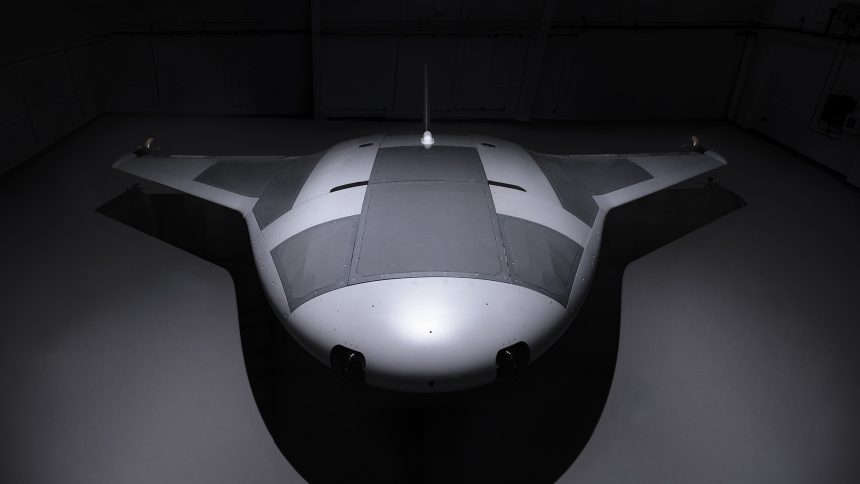The new class of Uncrewed Underwater Vehicles takes its name by the large “winged” fish that frequents the tropical waters.
On Apr. 8, 2024, Northrop Grumman Corporation released on line the first image of a full-size uncrewed underwater vehicle (UUV) prototype known as Manta Ray. According to Northrop, Manta Ray is new class of UUV, “an extra-large glider that will operate long-duration, long-range and payload-capable undersea missions without need for on-site human logistics.”
For the moment, the aerospace and defense company has released just a photograph of the prototype, with the tail section of the vehicle in the darkness, to hide some interesting details (more or less the same approach Northrop Grumman and the U.S. Air Force had with the much-awaited B-21 Raider bomber).
Manta Ray was built through a Defense Advanced Research Projects Agency (DARPA) program aimed at advancing key technologies to benefit future UUV designs, including techniques to manage energy, increased payload capacity, low-power propulsion and more.
In 2021, Northrop Grumman was awarded a Phase 2 contract to continue the Manta Ray program that began in 2020. As part of Phase 2, the two prime contractors, Northrop Grumman Systems Corporation and Martin Defense Group, would each develop unique full-scale demonstration vehicles.
Unmanned Undersea Vehicles
According to an article by Dr. Kyle Woerner, Program Manager of the TTO (Tactical Technology Office) the Manta Ray program page on the DARPA website:
Unmanned undersea vehicles (UUVs) that operate for extended durations without the need for human-present logistic support or maintenance offer the potential for persistent operations in forward environments. Such systems could allow traditional host vessels increased freedom of operational flexibility while providing traditional servicing ports with relief of workload.
The Manta Ray program seeks to demonstrate critical technologies for a new class of long duration, long range, payload-capable UUVs. If successful, this new class of UUV will give the combatant commander an amplification of capacity without disrupting current operations by remaining independent of manned vessels and ports once deployed.
The Manta Ray program plans to advance key technologies that will benefit future UUV designs, including, but not limited to:
- Novel energy management techniques for UUV operations and undersea energy harvesting techniques at operationally relevant depths;
- Low-power, high efficiency undersea propulsion systems;
- New low-power means of underwater detection and classification of hazards or counter detection threats;
- Mission management approaches for extended durations while accounting for dynamic maritime environments;
- Unique approaches for leveraging existing maritime data sets and exploiting novel maritime parameters for high-efficiency navigation and/or C3; and
- New approaches to mitigate biofouling, corrosion, and other material degradation for long duration missions.
Manta Ray is a multi-phase effort that includes at-sea demonstration of critical technologies. The program is using a disciplined systems engineering approach to define demonstration system objectives and identify enabling technologies needed for future systems.
According to Northrop Grumman, Manta Ray will have command, control, and communications (C3) capability to enable long-duration operations with minimal human supervision. The data from Manta Ray will help the joint force make better decisions and gain advantage during missions.
“Manta Ray will provide payload capability from the sea, making it a critical component of subsea warfare and the DoD’s Joint All Domain Command and Control (JADC2) vision,” said Alan Lytle, vice president, strategy and mission solutions, Northrop Grumman in a public statement dated 2022.
Manta Ray will also be able to anchor to the seafloor in a low power state while harvesting energy from the environment.
Inspired by nature
“A Manta Ray is a social creature that frequents the tropical waters of the Great Barrier Reef. Their curiosity and playful nature make the Manta Ray a favorite among scuba divers. Inspired by the graceful glide of these magnificent sea creatures, Northrop Grumman is creating a new class of UUV for undersea missions”, says the company in its website.
It’s not the first time an innovative technology developed by Northrop Grumman, is inspired (by accident or not) by mother nature: as already discussed here at The Aviationist, among the peculiarities of the B-2 Spirit stealth bomber there is also its leading edge design concept. In fact, the Spirit features a toothpick edge shape that turns into a “hawk’s-beak” profile in the nose. The shape of the leading edge was produced by Richard C. Scherrer, an engineer who had worked at Lockheed Martin Skunk Works, on the F-117, before joining Northrop Grumman for the Advanced Technology Bomber. The leading edge Dick Scherrer produced gave the B-2 the needed aero performance for the high subsonic airframe. In the end, the profile of a B-2 is not too different from the one of hawk or falcon.










